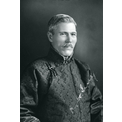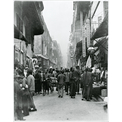-
History & Society
- Education in Pre-war Hong Kong
- History of Taikoo Sugar Refinery
- Hong Kong Products Exhibition
- Local Festivals Around the Year
- Post-war Industries
- Pre-war Industry
- The Hong Kong Jockey Club Archives
- Tin Hau Festival
- Memories We Share: Hong Kong in the 1960s and 1970s
- History in Miniature: The 150th Anniversary of Stamp Issuance in Hong Kong
- A Partnership with the People: KAAA and Post-war Agricultural Hong Kong
- The Oral Legacies (I) - Intangible Cultural Heritage of Hong Kong
- Hong Kong Currency
- Hong Kong, Benevolent City: Tung Wah and the Growth of Chinese Communities
- The Oral Legacies Series II: the Representative List of the Intangible Cultural Heritage of Hong Kong
- Braving the Storm: Hong Kong under Japanese Occupation
- A Century of Fashion: Hong Kong Cheongsam Story
Geography & EnvironmentArt & Culture- Calendar Posters of Kwan Wai-nung
- Festival of Hong Kong
- Ho Sau: Poetic Photography of Daily Life
- Hong Kong Cemetery
- Sketches by Kong Kai-ming
- The Culture of Bamboo Scaffolding
- The Legend of Silk and Wood: A Hong Kong Qin Story
- Journeys of Leung Ping Kwan
- From Soya Bean Milk To Pu'er Tea
- Applauding Hong Kong Pop Legend: Roman Tam
- 他 FASHION 傳奇 EDDIE LAU 她 IMAGE 百變 劉培基
- A Eulogy of Hong Kong Landscape in Painting: The Art of Huang Bore
- Imprint of the Heart: Artistic Journey of Huang Xinbo
- Porcelain and Painting
- A Voice for the Ages, a Master of his Art – A Tribute to Lam Kar Sing
- Memories of Renowned Lyricist: Richard Lam Chun Keung's Manuscripts
- Seal Carving in Lingnan
- Literary Giant - Jin Yong and Louis Cha
Communication & Media- Hong Kong Historical Postcards
- Shaw Brothers’ Movies
- Transcending Space and Time – Early Cinematic Experience of Hong Kong
- Remembrance of the Avant-Garde: Archival Camera Collection
- Down Memory Lane: Movie Theatres of the Olden Days
- 90 Years of Public Service Broadcasting in Hong Kong
- Multifarious Arrays of Weaponry in Hong Kong Cinema
-
History & SocietyGeography & EnvironmentArt & Culture
-
View Oral History RecordsFeatured StoriesAbout Hong Kong Voices
-
Hong Kong MemoryAll ItemsRecently Visited
Images

-
Governor Sir Richard Graves MacDonnell
Governor Sir Richard Graves MacDonnell (term of office: 1866-1872) supported the founding of a Chinese medicine hospital managed by Chinese people to solve hygiene problems. He officiated at the foundation stone laying ceremony for the Tung Wah Hospital in 1870 and also at the hospital's inauguration ceremony on 14 February 1872.-

- Unknown
-

-
Sheung Wan between Bonham Strand and Ko Shing Theatre
Sheung Wan between Bonham Strand and Ko Shing Theatre; taken around 1870. A Chinese residential area, the streets are packed with buildings, giving rise to appalling hygiene conditions.-

- c.1870
-

-
Street vendors in D'Aguilar Street, Central
Street vendors in D'Aguilar Street, Central, in the late 19th century. Hong Kong's development began after it opened its port to foreign trade and street vendors, coolies and masonry workers grew in number.-

- Late 19th century
-

-
Queen's Road Central in Central
Queen's Road Central in the early post-war period. In its early years, Hong Kong's British Government implemented administrative segregation of the city's Chinese and foreign populations. Foreigners mostly lived in an area stretching from Central to the Mid-levels, while Queen's Road Central served as Hong Kong's political and financial centre.-

- c.1945 to 1950
-

-
Criminal wearing pillory being put on public display under watchful eye of Indian police officer
Although Hong Kong was already a colony, the British continued to impose traditional Chinese penal measures on criminals. This photograph shows a criminal wearing a pillory being put on public display under the watchful eye of an Indian police officer. Information such as the criminal's name, the crime he has committed and the site of the crime is written on the wooden sign he is wearing, so as to deter others from breaking the law. This photograph was taken in the 1910s.-

- 1910s
-

-
Sir Robert Hotung
Sir Robert Hotung studied in Government Central School (the present-day Queen's College) in his early years. Upon graduation, Sir Hotung joined first Guangdong Customs and later Jardine, Matheson & Co. He was promoted to head comprador at Jardine Matheson and when he retired in 1900 he founded his own trading company. Sir Hotung went on to build his own business empire and became the first Chinese person permitted to live on Victoria Peak.-

- c.1910 to 1920
-

-
Ho Fook
Ho Fook, younger brother of Sir Robert Hotung, also graduated from Government Central School. Ho Fook's excellent command of English secured him comprador positions in E. D. Sassoon Sons & Co and Jardine, Matheson & Co, and he was later appointed as a Legislative Councillor. Sir Hotung and Ho Fook's journey to wealth through commerce and trading stands testament to the rise of Chinese businessmen in the late 19th century.-

- c.1900
-

-
Spectators at Happy Valley Racecourse
Happy Valley Racecourse in the late 19th century. In the early years, horse racing was a social activity enjoyed predominantly by foreigners in Hong Kong, and in this photograph only a handful of Chinese spectators can be seen in the stand.-

- 1894
-

-
Shops in Wellington Street, Central
Wellington Street in the early 20th century. This street in Central is full of shops and is littered with Chinese and English advertising and shop signs.-

- Early 20th century
-

-
Illustrations depicting bread-poisoning incident
The Illustrated London News reports on the bread-poisoning incident that shocked Hong Kong, with illustrations depicting "E-Sing Bakery" (top) and "Cheong Ah Lum of the bread-poisoning incident taken in for questioning" (bottom). On 15 January 1857, about 400 Europeans in Hong Kong suffered from poisoning after consuming bread from the E-Sing Bakery. Cheong Ah Lum, the proprietor, and a few of his workers were arrested, but they were acquitted of all charges for lack of evidence. Despite being acquitted, Cheong and his workers were fined and deported from Hong Kong. The bread-poisoning incident illustrates the tension that existed between Chinese and foreign residents of Hong Kong at that time.-

- 1857-03-28
-
Copyright © 2012 Hong Kong Memory. All rights reserved.
| Set Name |





